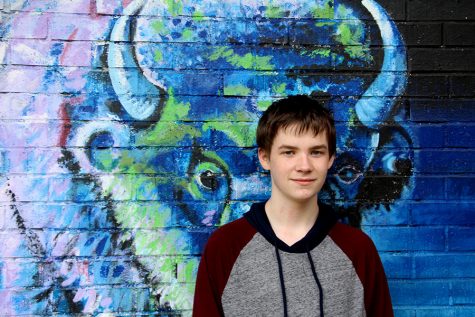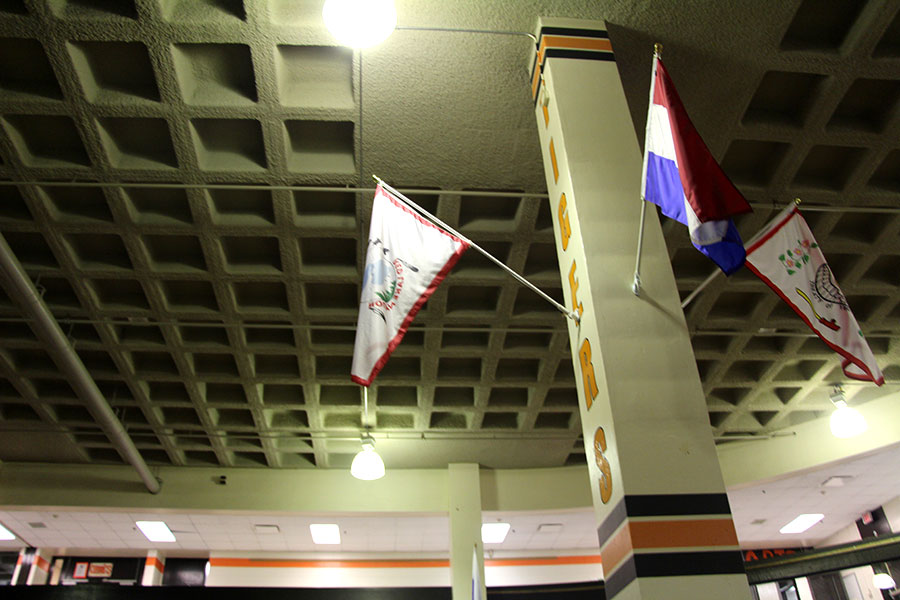South recognizes nations close to home
Pictured above the Red Lake flag in the middle of the commons is one of the seven new flags put up to represent tribal nations within minnesota. Photo: Oliver Hall
All Nations is undeniably an important part of the South high community. It is another program similar to OPEN and Liberal Arts, but some argue it is not always seen as one. But some argue that the new flags in the commons will help get All Nations more recognition in the school.
Letisia Leon, a junior in the All Nations program argues, “All nations is basically in a little corner. There’s three classrooms and we don’t get that much attention unless we do walkouts or something. People will look up and see those flags and see there’s some type of native stuff going on.” Leon described the flags by saying “They’re the flags of the Ojibwe tribes representing the students here who are in the all nations program from around Minnesota.” While only seven flags are up so far, theoretically eleven flags from native tribes in Minnesota will be put up in total. The flags that will soon be put up are the flags for: White Earth Band of Chippewa (Ojibwe) Indians, Upper Sioux Dakota Indian Community, Shakopee Mdewakanton Sioux Community, Red Lake Nation Band of Chippewa, Prairie Island Indian Community, Mille Lacs Band of Ojibwe, Lower Sioux Indian Community, Leech Lake Band of Ojibwe, Grand Portage Band of Lake Superior Chippewa, Fond Du Lac Band of Lake Superior Chippewa, Bois Forte Band of Chippewa.
Sean Mattner an English teacher in the All Nations program believed the flags will have a notably positive impact “I think it will get students to understand a little more about the past and maybe break out of their own bubbles and have them talk to other students within South about what it means to be Native Americans”
Vincent Patton, a Social Studies teacher in the program, believed that the new flags were significant as well. He said, “For many years there were flags from all kinds of nations in the commons except native american nations of the land that they were on. My students fought for it to bring them in to represent South.”
Mattner believes the flags will help All Nations get more recognition. “I think that for many years All Nations has struggled to find its place and now that we have the flags up in our commons area I think more people are recognizing that we are here and we are strong as a community and as a program.” Leon believes the new flags signify the relationship between South and and the program. “I mean obviously it shows that [South] cares that they let us do it. They let us hang the flags and stuff and that they respect us enough to allow that to happen.”
David Michael Butler is a program coordinator for All Nations and he had this to say about the impact of the new flags. “Well I don’t know what impacts it has had on the students here but as an adult it means a lot to me because I’ve been through the high school experience and I’ve been through college it means a lot more to me because I’ve always been underrepresented everywhere I’ve gone and now actually working here and knowing that our program and our nations, our sovereign nations are represented it really brings a sense of pride to me that I work here and at a school that would recognize that.” He believes Tami Johnson, a counselor here at South had a big impact as far as getting the flags in the common goes, he said “Been a few attempts at putting up flags representing native americans in the commons. Tami Johnson has been the most successful she did everything pretty much all on her own.”
Johnson described the series of events over email. that led to the flags being placed in the commons. “Earlier this year, a Minneapolis family expressed concern that our schools had the flags of many nations represented but had no Native flags to represent the indigenous communities they serve. So, in January I reached out to our 11 Indigenous tribes in MN and requested flags for 3 of our high schools with high Native student numbers. Many tribes responded immediately and gifted us with their sovereign Nation’s flags. A few tribes are working hard to honor our request and we look forward to receiving their flags very soon. The administration and engineers had to order the poles and brackets for the flags and put in a work order to get the brackets in place before we could raise the flags in May. It was a team effort!”
While Johnson didn’t work alone she was a very important part of organizing the new flags being placed in the commons.
Leon went on to elaborate on why she believed the flags were going to be a positive thing, “I think it’s good that they did that and that it’s really gonna represent all nations more.” The flag is very likely to get the All Nations program more recognition from students and faculty. More and more All Nations is helping South recognize the importance of every student in South and the importance of where everyone came from.

As he starts his third year on the Southerner, junior Oliver Hall is ready to bring his experience as staff writer to the newer student journalists joining...











